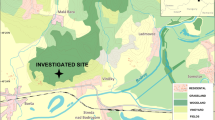Abstract
IN a recent issue of Nature1 it was pointed out that Iversson had produced evidence from pollenanalysis of lake-muds that, in parts of Denmark colonized by Neolithic man, the continuity and composition of the natural mixed oak forest cover had been much altered by the human introduction of forest clearance by fire. It now seems appropriate to give results which point in a similar direction for the great heath-land area of East Anglia known as the 'Breckland'. The ecological status of the varied plant-communities of grass-heath, sand-sedge, bracken, ling, and sparse woodland has long been in dispute, especially as regards their relation to the factors of climatic, biotic and edaphic (soil) control. It has sometimes been suggested that the rainfall and porous soil may in themselves prevent the development of natural woodland; but others have regarded the heavy grazing, formerly by sheep and now by rabbits, as the only factor preventing recolonization of the heaths by woodland. The basal question has remained unanswered, whether this heathland is determined as such by natural factors, or whether it represents the effect of human interference upon native woodland.
Similar content being viewed by others
References
Nature, 153, 511 (1944).
Author information
Authors and Affiliations
Rights and permissions
About this article
Cite this article
GODWIN, H. Age and Origin of the 'Breckland' Heaths of East Anglia. Nature 154, 6–7 (1944). https://doi.org/10.1038/154006a0
Issue Date:
DOI: https://doi.org/10.1038/154006a0
- Springer Nature Limited
This article is cited by
-
Dating of Humus Podzols By Residual Radiocarbon Activity
Nature (1964)
-
Atmospheric Pollen in Relation to Land Use
Nature (1959)
-
Neuere Arbeiten zur sp�t-und nacheiszeitlichen Vegetations-und Klimageschichte der Britischen Inseln
Die Naturwissenschaften (1947)





